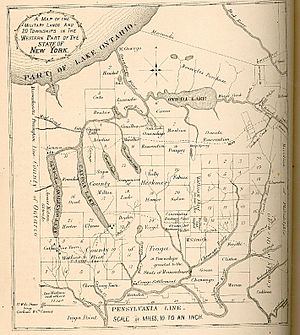Boston Ten Townships facts for kids
The Boston Ten Townships was a large area of land in New York State. It covered about 230,400 acres (932 square kilometers). This land is now part of Tioga County and Broome County.
The area stretched between the Chenango River and the Tioughnioga River on the east. Its western border was the west branch of Owego Creek. It started from the Susquehanna River and went north for about twenty-five miles.
Today, this land includes parts of several towns. These are Owego, Newark Valley, Berkshire, and Richford in Tioga County. It also includes parts of Lisle, Nanticoke, and Maine in Broome County.
Contents
How the Land Was Formed
The Treaty of Hartford
In 1786, an important agreement called the Treaty of Hartford was made. This treaty settled a long-standing argument. It decided the border between Massachusetts and New York State.
New York gained full control over this land. However, Massachusetts was given a special right. It could buy the land rights from the Native American tribes who lived there.
The Boston Purchase Company
Later that same year, a group of investors from Boston bought this right from Massachusetts. This group was called the Boston Purchase Company. There were originally 11 investors, and later 60.
One of these investors, Colonel Avid Pixley, traveled to the area. His job was to talk with the Native Americans about buying the land.
Buying Land from the Oneida People
Most of the investors eventually moved to this new area. They were able to buy the land from the Oneida tribe. This meant the Oneida's claims to the land were settled.
However, a small part of the land, half of the town of Owego, had already been bought. A person named James McMaster had acquired it from the Oneida. After some discussions, his claim was officially recognized. This part of the land became known as the McMaster Patent.


